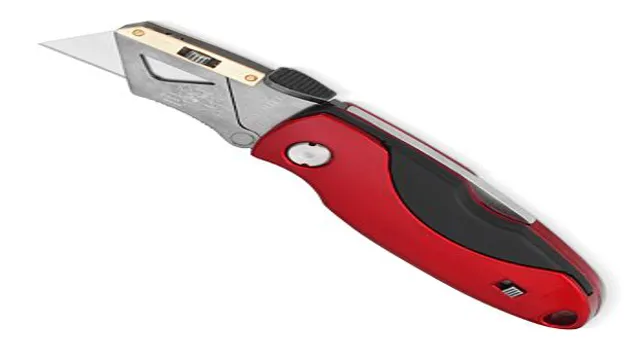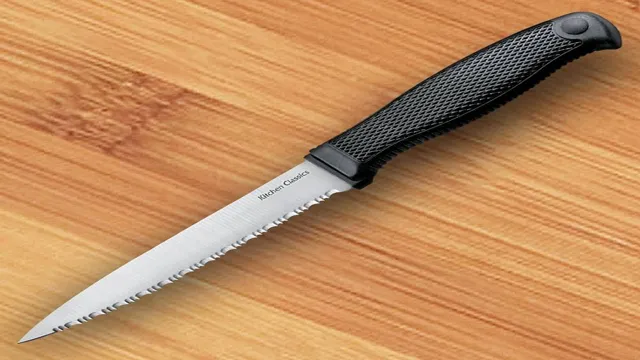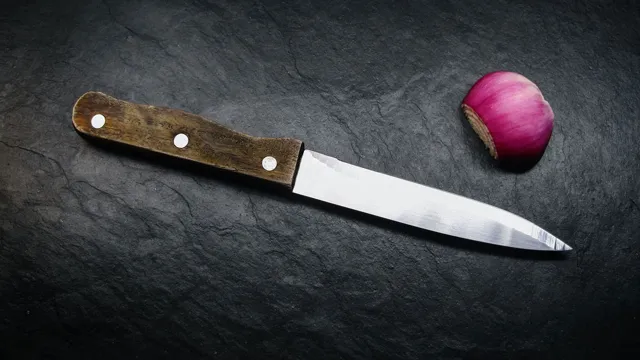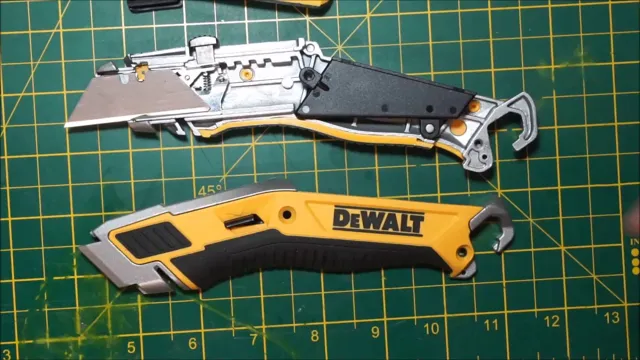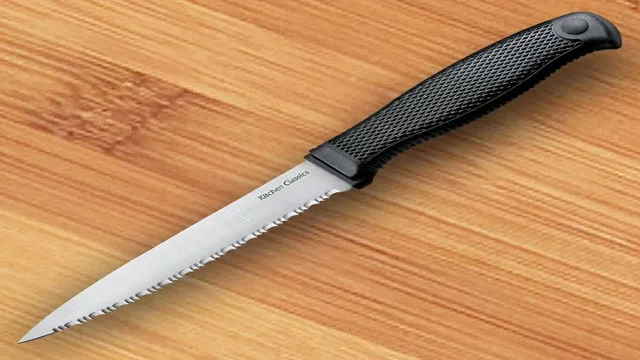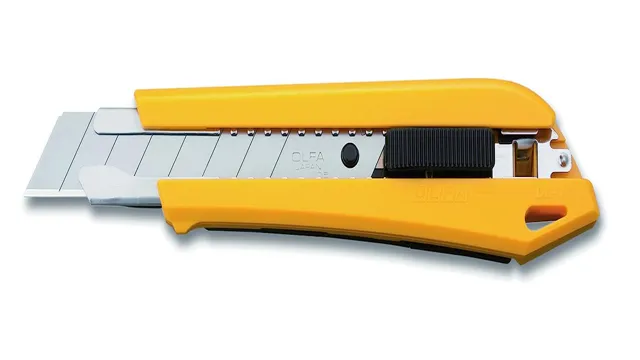What is a Serrated Utility Knife and How to Choose the Best One: A Complete Guide
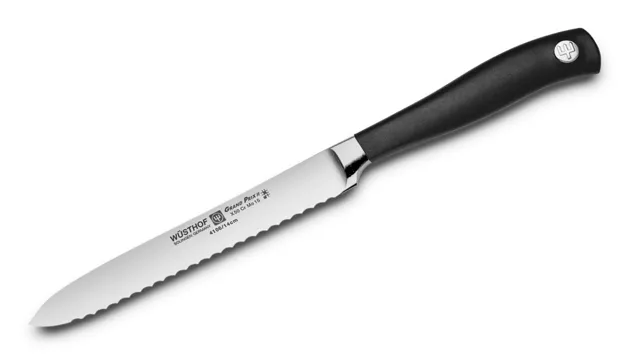
Have you ever struggled to cut through tough meats or thick-skinned produce, like squash or pumpkin? Or have you found that a typical kitchen knife just doesn’t do the job? Enter the serrated utility knife. A serrated utility knife is a versatile kitchen tool capable of handling tough-to-cut foods with ease. Its serrated edge allows it to saw through meats, vegetables and fruits without crushing them, making it an excellent addition to any culinary collection.
Think of a serrated utility knife as a miniature saw, with teeth that grab and cut through the food as you slice, rather than just pressing against it like a typical kitchen knife. It can work wonders for tasks such as slicing tomatoes or cutting bread. While many kitchen knives come with a straight edge, the serrated utility knife’s sharp, jagged edge makes it the perfect tool for tougher cutting tasks.
Its compact size and ease of use make it a go-to for many chefs, from home cooks to professionals. If you’re someone who enjoys cooking and wants to take your culinary skills to the next level, a serrated utility knife is an excellent investment. Once you start using it, you’ll wonder how you ever managed without it.
Understanding Serrated Blades
If you’re looking for a knife that can handle all sorts of cutting tasks, a serrated utility knife is definitely one to consider. Serrated blades have a unique edge that can easily tear through tough materials like bread, meat, and vegetables, making them a versatile tool to have in your kitchen. Unlike straight blades, serrated blades have teeth that grip whatever you’re cutting and make quick work of it.
They’re particularly useful for slicing tomatoes, where a straight blade would just squish them. So, what is a serrated utility knife exactly? It’s a general-purpose knife with a serrated edge that can handle a range of tasks from slicing bread to carving meat. Whether you’re a professional chef or just a home cook, a serrated utility knife is a valuable addition to any knife set.
Serrated vs. Plain Edge Blades
When it comes to choosing a knife, the type of blade edge is an important factor to consider. Serrated blades differ from their plain edge counterparts in that they have teeth-like protrusions, which can be beneficial for certain tasks. For example, a serrated knife is ideal for slicing through crusty bread or cutting through tough materials like rope or leather.
The serrations allow the blade to grip and tear through the material, which is more difficult to achieve with a smooth edge. However, for tasks that require precision cutting, such as peeling a delicate piece of fruit or filleting a fish, a plain edge blade may be a better choice. The smooth edge allows for clean, precise cuts without damaging the material.
Ultimately, the choice between a serrated and plain edge blade depends on the intended use of the knife.
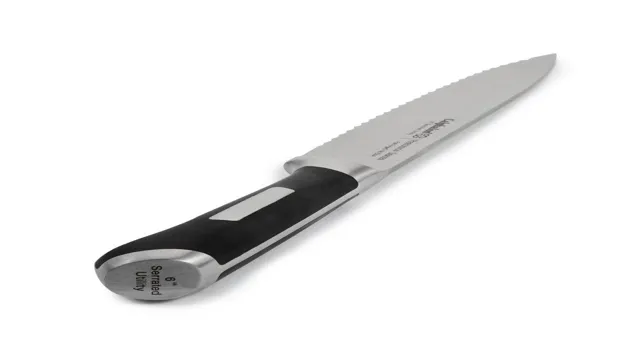
Benefits of Serrated Blades
Serrated blades are often used for cutting tough materials such as rope, fabric, and bread. These blades have a special edge design that consists of pointed teeth, allowing for a sawing motion while cutting. One of the benefits of serrated blades is that they are able to cut through materials that cannot be sliced with a straight blade.
The teeth grip onto the material, making it easier to slice through. Additionally, the design of the serrated blade helps to reduce the amount of pressure needed to cut through tough materials. This means that the user does not have to apply as much force, resulting in less fatigue and strain on their hands and arms.
Overall, the unique design of serrated blades makes them a useful tool for various cutting tasks, offering a high level of precision while being versatile and durable.
Uses of a Serrated Utility Knife
If you’re wondering what a serrated utility knife is, it’s a versatile tool that comes in handy for a wide range of tasks in the kitchen. The serrations on the blade of the knife enable it to cut through tough foods with ease, making it perfect for tasks like slicing bread, tomatoes, and other produce without squishing them. The knife’s serrated edge also enables it to grip onto the food, making it easier to cut through it without slipping.
Additionally, the knife’s smaller size makes it perfect for tasks like trimming meat, portioning out dough, or cutting through delicate foods without tearing them apart. Its compact size and versatility make it a great addition to any kitchen, whether you’re a professional chef or a home cook. Whether you’re an avid cook or just starting out, a serrated utility knife is a must-have tool that you’ll find yourself reaching for time and time again.
Slicing Tomatoes and Citrus Fruits
When it comes to slicing tomatoes and citrus fruits, a serrated utility knife is the way to go. Its teeth, or serrations, grip the skin of the fruit, allowing you to make clean, straight cuts without crushing or tearing the soft flesh. This type of knife is especially useful for tomatoes, which can be difficult to cut cleanly with a regular chef’s knife.
The serrated edge is also ideal for slicing through the tough rind of citrus fruits, such as oranges and grapefruits. Plus, the pointed tip of the serrated utility knife allows for precise cuts around the stem or core of the fruit. When selecting a serrated utility knife, look for one with a comfortable grip and a blade that is long enough to handle larger fruits, but not so long that it becomes unwieldy.
With a sharp serrated utility knife, you’ll be able to make quick work of slicing tomatoes and citrus fruits for your favorite recipes or snacking.
Cutting Bread and Pastries
A serrated utility knife is a versatile tool that can be used for a variety of purposes, especially when it comes to cutting bread and pastries. The serrated edge of the knife allows for clean and precise cuts without crushing or tearing the delicate texture of the food. Whether you’re slicing a loaf of bread, cutting through a flaky croissant, or trimming the edges of a cake, a serrated utility knife is the perfect tool for the job.
The long, pointed blade of the knife can easily cut through crusty breads, while the serrations help to saw through soft and flaky pastries without squishing them. The ergonomic handle provides a comfortable grip, allowing you to slice through your baked goods with ease. Additionally, the serrated utility knife is an all-purpose tool that can also be used for slicing fruits and vegetables, making it a great addition to any kitchen.
When selecting a serrated utility knife, look for one with a high-quality stainless steel blade that is durable and easy to maintain. Make sure that the blade is sharp and that the serrations are evenly spaced for a consistent cut. With a serrated utility knife in your kitchen arsenal, you’ll be able to tackle any bread or pastry with confidence and ease.
Carving Meats and Poultry
When it comes to carving meats and poultry, having the right tools is essential for creating precise cuts. One tool that should not be overlooked is the serrated utility knife. This knife is perfect for slicing through tough meats like roasts or turkey.
The serrations grip the meat, allowing for a smoother cut without tearing or shredding the meat. Additionally, the pointed tip of the knife enables precise control while cutting around bones or joints. Whether you’re a professional chef or a home cook, a serrated utility knife should be a staple in your kitchen.
It’s a versatile tool that can help you create beautiful cuts and enhance the visual appeal of your dishes.
Choosing the Right Serrated Utility Knife
When it comes to finding the perfect serrated utility knife, there are a few things to consider. First things first – what is a serrated utility knife? It’s a versatile cutting tool that has small serrations along the blade, allowing it to cut through tough materials like bread, fruits, vegetables, and meats without crushing or tearing them. The size of the serrations can vary, depending on the intended use – larger serrations are great for cutting through thicker materials, while smaller serrations are ideal for more delicate cuts.
The handle of the knife should also be considered – a comfortable grip can make the difference between a successful cut and a slip-up. So, whether you’re a professional chef or a home cook, choosing the right serrated utility knife can make all the difference in the kitchen.
Blade Material
When it comes to choosing the right serrated utility knife, one of the most important factors to consider is the blade material. Generally, there are two types of blade materials to choose from: stainless steel and carbon steel. Stainless steel is a popular choice as it is easy to maintain, resistant to rust and corrosion, and does not require frequent sharpening.
On the other hand, carbon steel blades are known for their sharpness and edge retention, making them a great choice for heavy-duty tasks. However, they require more maintenance and need to be dried thoroughly to prevent rusting. Ultimately, the choice between the two types of blade materials will depend on your specific needs and preferences.
If you prioritize ease of maintenance, then stainless steel is a great option. But, if you’re after sharpness and durability, then carbon steel is the way to go.
Handle Material
When it comes to choosing the right serrated utility knife, there are a lot of factors to consider – one of which is the handle material. The handle is an important part of the knife, as it affects both the comfort and the safety of using it. There are many different materials to choose from, including wood, plastic, stainless steel, and more.
Each material has its own strengths and weaknesses, so it’s important to think about what you’ll be using the knife for and what kind of handle will be most comfortable and safe for you. If you’re looking for a knife with a more traditional feel, a wooden handle might be a good choice. Wood is comfortable to grip and aesthetically pleasing, but it requires more maintenance than other materials and can be more prone to cracking or warping.
Plastic handles are a popular choice for their durability and ease of maintenance, though they might not offer the same level of comfort as other materials. Stainless steel handles are strong and durable, but can be slippery when wet. Ultimately, the right handle material will depend on your personal preferences and the intended use of the knife.
Whether you prioritize comfort, durability, or aesthetics, there’s a handle material out there that will suit your needs. Keep in mind that a comfortable and safe handle can make all the difference when it comes to using your knife effectively and efficiently. So take the time to consider your options and choose a serrated utility knife that will serve you well for years to come.
Conclusion
In conclusion, a serrated utility knife is the Donald Trump of kitchen knives – rough and ready. With its jagged edges and versatile blade, it can tackle any task from slicing bread to sawing through tough meats. This knife is definitely not a delicate flower, but its brutal efficiency and unwavering strength make it a valuable addition to any home cook’s arsenal.
So if you want to cut through the competition in the kitchen, grab yourself a serrated utility knife and slice, dice, and conquer.”
FAQs
What is a serrated utility knife?
A serrated utility knife is a type of kitchen knife with a serrated edge that is designed for cutting foods with tough exteriors and soft interiors.
How is a serrated utility knife different from a normal knife?
A serrated utility knife has a serrated edge that helps to grip and cut through tougher materials, while a normal knife has a straight edge that is better suited for slicing and chopping.
What foods should I use a serrated utility knife for?
Serrated utility knives are great for cutting through bread, tomatoes, citrus fruits, and other foods with tough exteriors and soft interiors.
Can I sharpen a serrated utility knife?
Yes, you can sharpen a serrated utility knife, but you will need a special sharpening tool that is designed specifically for serrated knives.
How often should I sharpen my serrated utility knife?
It depends on how often you use your knife, but most knives should be sharpened every 6-12 months.
What are some good brands of serrated utility knives?
Some popular brands of serrated utility knives include Wusthof, Victorinox, and Shun.
Can a serrated utility knife be used for other tasks besides cutting food?
Yes, serrated utility knives can be used for a variety of tasks, such as cutting through cardboard, rope, and other tough materials.

